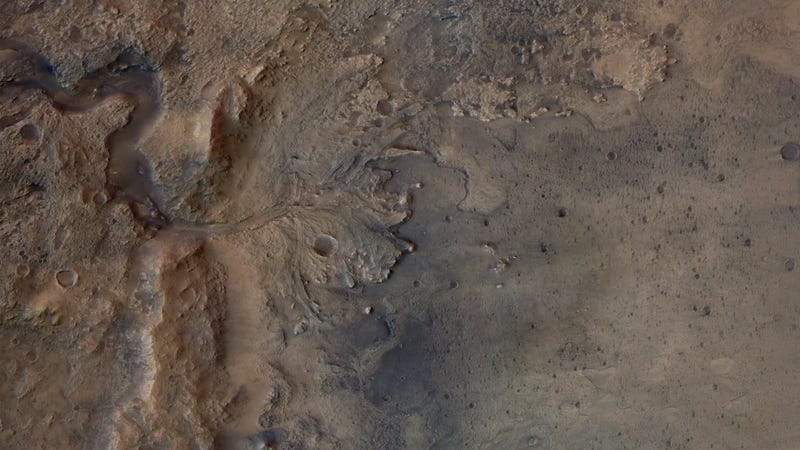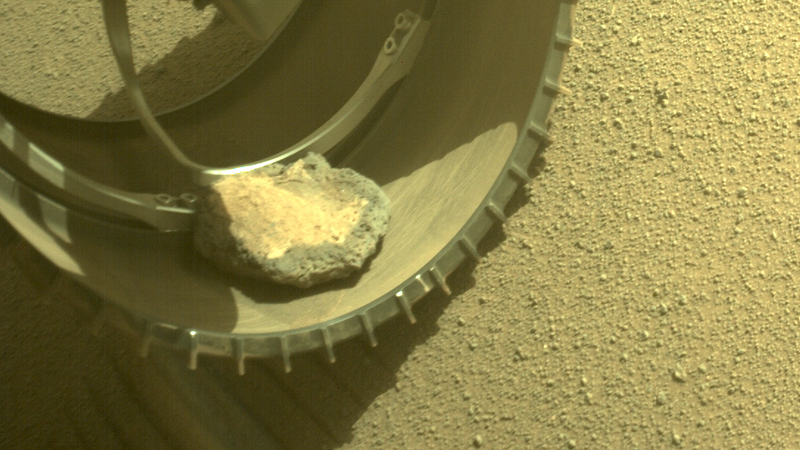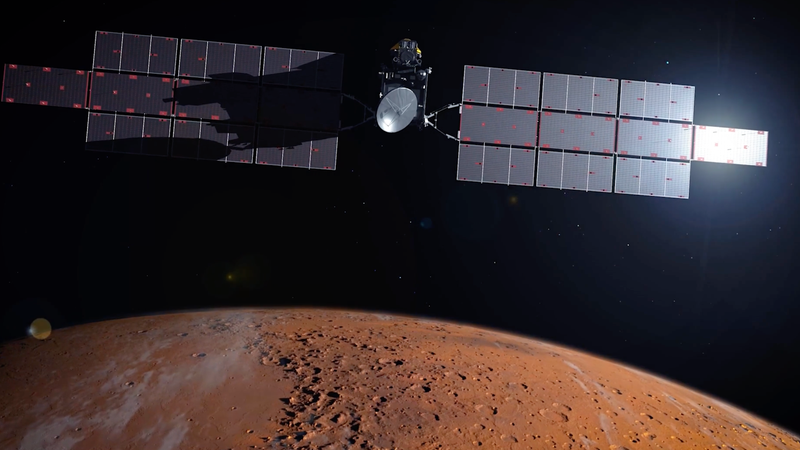Earlier this week, scientists announced that Perseverance found organic molecules on Mars. Not life itself—hardly—but another endorsement of the ancient habitat on Mars as having been suitable for life.
Perseverance has been searching for biosignatures—that is, signs of ancient life on Mars—since it landed on the Red Planet in February 2021. But the search for that life began years before Perseverance even left Earth, with the labors of the Curiosity rover.
Curiosity launched for Mars in 2011, a decade before the Perseverance rover was plopped onto the red Martian terrain. Within eight months of arriving on Mars, Curiosity achieved its major goal: finding evidence of a past environment on Mars that could have supported microbial life.
Now a decade on, Perseverance is carrying on the mantle by searching for evidence of microbial life itself. At the same time, Curiosity is continuing its investigation of ancient Martian environments. Though thousands of miles apart, the two rovers’ findings are giving scientists a new look at Mars as it existed billions of years in the past.
Here’s a look back at the discoveries that contributed to this week’s finding.
Water on ancient Mars (lots of it)

Curiosity and Perseverance are both exploring sites where water flowed in the ancient past. In December 2022, Curiosity snapped shots of apparent water ripples, frozen in time in the Martian rock—yet another indicator that the rover is roaming around an ancient lakebed.
Alluvial fans in Martian craters and geological formations in the planet’s largest canyons are also indicators that the world was once awash in water.
Ancient water is not always science’s friend

Water anywhere is a boost to hopes that life may exist there, or in the case of now-arid Mars, have existed there in the ancient past.
But the Curiosity rover found rock samples in Gale Crater in 2019 that appeared to be washed clean of their geologic record. The culprit, according to scientists who reviewed the mud layers, was briny water that leeched through an ancient lake bed, altering the layers of minerals on the site.
On Mars, not all stones reveal the full story. This gives scientists even more reason to image a large quantity of rocks, in order to better understand the geological and fluvial processes on the planet.
Understanding organics

Sometimes, scientists use the term “organic matter” in reference to molecular-scale structures that are often connected with stuff that is alive. Last year, Gizmodo reported that a 4-billion-year-old Martian meteorite found in Antarctica contained no evidence of alien life, clearing up decades of speculation about minuscule structures embedded in the rock.
A paper published last year posited that what some had argued where microscopic fossils in the meteorite were actually resultant from abiotic processes. Gizmodo wrote at the time:
Now, just because something is described as “organic” doesn’t necessarily mean it has anything to do with life. Organic molecules are typically composed of carbon and hydrogen, and sometimes oxygen, nitrogen, and sulfur. Sure, these molecules are often associated with biological processes, but they can arise from abiotic processes as well, in what’s known as abiotic organic chemistry.
That’s especially relevant in understanding all discoveries of organic molecules on Mars, not just Perseverance’s recent find.
Life…finds a way

To cover astrobiology is to surrender oneself to the relentlessly applicable line delivered by Jeff Goldblum in Jurassic Park. There’s plenty of life on Earth that shows the extremes at which organisms can eke out an existence, and even thrive.
Astrobiology takes the rules life seems to follow and applies them to the cosmos. Because space is inhospitable, it often means understanding how the most primordial life on Earth existed, as well as how the hardiest organisms around today make do in their environments.
For example, tardigrades—sometimes referred to as water bears or moss piglets—are so damn hardy that a team of scientists conducted a series of tests on them to investigate whether organisms like them might be capable of surviving atmospheric reentry while hitching a ride on asteroids.
Last year, a team of researchers posited that one remarkably durable microbe (Deinococcus radiodurans) could have survived radiation just underneath Mars’ survive for about 280 million years. That’s not to say microbes did, of course, but it’s good that scientists are exploring the limits of what’s possible.
Curiosity…5 years ago

Perseverance is not even the first rover on Mars to find evidence of organics. Curiosity detected 3.5-billion-year-old organics in Mars’ Gale Crater back in 2018. Two papers on the findings revealed that Curiosity detected carbon-containing organic matter (note: this does not mean organic matter in the sense of decomposing remains of a living thing, just organics on a molecular level), and that methane levels around the rover varied by season.
Curiosity is also regularly imaging signs of ancient water in Gale Crater. The above shot was taken in June 2022, and showcases layers of flaky rocks that may have sat at the bottom of an ancient stream or pond.
What is Perseverance looking for?

Perseverance is going a step beyond Curiosity’s stated mission goals, and with a more modern suite of instrumentation. The newer rover is seeking signs of ancient life on Mars—a mission emboldened by Curiosity’s discovery of ancient environments suitable for life as we know it.
On Earth, the most ancient signs of life are stromatolites, or microbial mats left behind by microorganisms. Earth’s most ancient stromatolites are several billion years old. The prevailing scientific thinking on the matter is that, if life did once exist on Mars, it probably looked like the organisms that produce stromatolites, which inhabit shallow flowing waterways.
Ergo: The impetus to dispatch a rover capable of investigating the river delta that flowed into Jezero Crater.
Perseverance’s arsenal

Any $US2.7-billion rover worth its salt is equipped with the right gear for deciphering every little feature it sees on a world hundreds of millions of miles away. After all, once it gets there, there’s no coming back.
Perseverance hosts a suite of imagers for mapping out the Martian terrain, but also scrutinizing the itsy-bitsy elements contained in Martian rock samples. As reported by Gizmodo in 2021:
[I]t’s easy to forget about the impressive arsenal of imaging technology at Perseverance’s disposal: There’s the chemistry-sensing, laser-shooting SuperCam; the x-ray rock-reader known as PIXL; and the Mastcam-Z imager (which you may remember was taking all those photos of Ingenuity in flight).
But that’s not all. There’s also the WATSON camera on the end of the rover’s robotic arm, which will allow the folks at NASA up-close looks at the rock samples. WATSON is part of SHERLOC (NASA loves an interplanetary Victorian literature reference), which can scrutinize rock for organic compounds and minerals that indicate how the rocks formed.
It was the SHERLOC camera that spotted signals of organic molecules in the rocks in Jezero Crater this week.
Perseverance’s life-hunting kickoff

Perseverance truly started its investigation of ancient Martian rock three months into its stay on Mars. The holdup? The Ingenuity helicopter, which stowed away on Perseverance for the trip to Mars, was given the first couple of months to get off the ground. In April 2021, Ingenuity took off and landed, becoming the first to achieve a powered, controlled flight on another planet.
So in May 2021, Perseverance was finally able to embark on its scientific campaign beyond the odd photo of a rock here and there.
Jezero’s ancient waterways

The Mars 2020 mission team selected Jezero Crater as Perseverance’s landing spot for a very specific (read: aqueous) reason. In its ancient past, scientists think Jezero was an ancient lake fed by many waterways. On its western end, those waterways took the form of a river delta, long since dried up.
In May, Perseverance (finally out of the crater and into the delta) found evidence that at least one of the rivers flowing into Jezero was deeper and more turbulent than previously thought. The energetic water probably even carried boulders from farther off in the Martian landscape into the crater.
More imaging of the area will improve scientists’ ability to reconstruct that ancient fluvial scene.
How long did Mars’ water flow?

Last week, an interdisciplinary team calculated the flow rate of rivers on Mars and Titan, Saturn’s largest moon. The researchers tweaked equations initially developed to calculate the flow of rivers on Earth.
The team found that rivers in Gale Crater (Curiosity’s domain) probably flowed for at least 100,000 years; in Perseverance’s Jezero Crater they probably flowed for at least 1 million years.
“The Martian rivers we studied were not just fleeting; they appear to have flowed over prolonged time periods during which conditions favourable to life may have been maintained,” Taylor Perron, a planetary scientist at MIT and the study’s co-author, told Gizmodo in an email. “The flow rates in the rivers we studied on Titan may be as large as in big rivers on Earth, even though Titan is smaller than Earth.”
The occasional rocky companion

For over a year, Perseverance had a rock in its shoe—erm, tread. The rock didn’t hamper scientific exploration of Jezero Crater, nor the river delta on its western end, and the rover finally shook it loose in April 2023. (Commenters noted that the rover probably could’ve done with some sidewalls on its wheels.)
In a way, the rock was a reminder of how far the rover has come…am I trying too hard here? Whatever, the rock was a cute episode in Perseverance’s story, and I couldn’t leave it out.
Stockpiling the sample cache

Besides imaging Martian rocks, Perseverance spent plenty of time and energy collecting rocks. These rock cores will eventually—with any luck—be the samples shipped to Earth in the early 2030s. Perseverance completed its sample cache in January 2023, nearly a year to the day since the rover began collecting its cores.
This rock contains organic molecules

Meet Quartier, a rock target imaged by Perseverance’s WATSON and SHERLOC instruments. This week, scientists announced that Perseverance spotted signs of organic molecules in Quartier.
According to a JPL release, if the apparent organic molecules are confirmed as such, they probably were formed by geological processes (of which there were plenty!) rather than biological sources. Hate to burst your bubble, but finding fossils of incredibly small, extraordinarily ancient life was never going to be easy.
What’s next?

The obvious endgame of the Perseverance mission is for scientists on Earth to get their hands on the Martin rock samples the rover has been collecting. Of course, Mars is over 200 million miles away at time of writing. The Mars Sample Return mission is as ambitious as it is expensive, currently clocking in at nearly $4.5 billion. It will involve a handful of spacecraft and will take at least a decade (emphasis on at least) to complete.
NASA and the European Space Agency are actively tinkering with the mission plan, so costs and timelines will almost certainly change. Let’s hope that the two (yes, not one but two) review boards established to manage the sample return program do their jobs well, and ensure the mission gets off the ground in a timely fashion.
Getting Martian rock samples to Earth would be the first time a piece of another planet is ever brought to our own, and would make the Martian material a lot more accessible for study. You know, whenever it actually happens.
Tightening budgets, vanishing hopes

Until space agencies gin up funds to land craft beyond Mars in earnest, the search for life will stay focused on the fourth planet from the Sun.
That’s not to say Mars isn’t a compelling venue for astrobiological inquiry. It absolutely is! But farther-flung stretches of our solar system—namely the subsurface seas of Europa and Enceladus—are equally compelling, if not moreso for the water that actively flows beneath their crusts.
Unfortunately, the Mars mission is already on shaky ground. As reported by Gizmodo in April, NASA needs an additional $250 million this fiscal year to ensure the sample return can launch by 2028.
Furthermore, last month NASA’s deputy administrator announced that the agency probably wouldn’t get its full budget request for 2024. The belts are tightening around the federal government’s waist, and the search for life is suffering for it.
